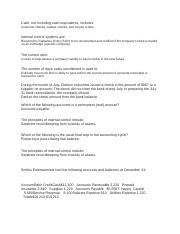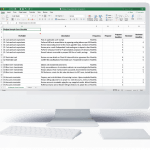
All you need is a simple statement showing your current cash position, expected cash receipts during the next week/month and expected cash payments during the next week/month. To download a free customizable cash flow statement template, click here. Can I use this Monthly General Accounting Checklist Template for weekly processes as well? This checklist template is specifically for monthly general accounting. Our monthly general accounting checklist template will allow you to effectively delegate work to your team members without batting an eye. Using the checklist, they will understand the minute steps it takes to get the work done.
Review actual profit loss vs. budget and vs. prior period
Paying employees every week (or every other week) also helps prioritize payroll tax withholding and check employee timesheets. If your employees clock more than 40 hours a week, you might be liable to pay them overtime. It doesn’t hurt to keep a close watch on their timesheets to avoid surprises and allocate budgets accordingly. To make your life easier, consider using expense management software. You can track everyday business expenses from communication tools, contractors, and rent in one seamless dashboard. Businesses can also manage their travel and entertainment expenses without the constant headache of submitting manual expense reports.
Monthly General Accounting Checklist Template FAQs
With weekly invoices, the product or service you provide to customers is still fresh in their minds, so there’ll likely be fewer questions or qualms about the bill. If you wait too long to bill your client, you’re more likely to result in a delinquent payment. Odds are most of your accounts receivable are electronic payments, so you don’t need to make daily trips to the bank.
What Is Included in the Accounting Checklist?
Though sales tax payments are required every quarter, making monthly calculations is a much more manageable task. At the same time, you can also estimate any county or city-level sales tax your clients must pay. Reconciling these accounts with month-end data gives you a real-time view of a client’s cash balance.
Reconciling accrued expenses will help you stay on top of all invoice payments and dues within a year. Prepare a bank reconciliation to reconcile your bank account with your financial records. Bank reconciliations will also help you understand bx cable definition your cash situation and not overdraw your account. Reconciling cash and receipts at the end of each day helps you discover cash shortages or overages quickly, so you can figure out where the money went and identify errors or theft.
Annual bookkeeping to-do’s
Missing payments could incur charges or interest, or the damaging of valuable business relationships. Another part of this is to check you’re receiving what you are paying for. This seems simple enough, but as organizations grow and become more complex it can be easy to miss certain details. This is why we’ve created 11 checklists to guide you through your accounting processes. While you’re at it, you’ll identify trouble spots and make adjustments to improve sales and margins. Your profit and loss statement (also known as P&L or an income statement), both for the current month and year-to-date, tells you how much you earned and how much you spent.
If you don’t put a process in place for your accounts payable then you could be facing late payment charges or even opening up space for fraud. If you do not write down unsellable inventory, you are overstating your inventory balance and paying additional taxes that you don’t owe. If your taxable supplies reach more than $1.5 million you must switch to quarterly reporting, and if they exceed $6 million, you must switch to monthly reporting.
Year-end is a busy time for accountants, so here are two of the most important tasks to complete and bring the year to a close. Similarly, confirm whether any invoices you’ve sent on behalf of your clients were left unpaid each week. Follow up if needed to collect payment and be sure you sent the invoices to the appropriate customers. Rather than disappointing your clients, keep your team organized by creating detailed checklists to stay on track. A simple way to do that is with spreadsheets, using Google Sheets or Microsoft Excel. According to American Productivity & Quality Center (APQC), only about 25 out of 100 businesses are able to close up their books in 10 days at the end of the year.
- This weekly review helps clients avoid late fees or upsetting their vendors and suppliers.
- Forecasting how much cash you will need in the coming weeks/months will help you reserve enough money to pay bills, including your employees and suppliers.
- If your card doesn’t have the Visa or MasterCard logo, it can only be used to make ATM cash withdrawals.
- Forecasting how much cash you will need in the coming weeks and months will help you reserve enough money to pay bills, including your employees and suppliers.
This task also allows you to monitor labor costs so your clients know whether they’re within budget or need to tweak their scheduling. Check out our guides to download a free customizable budget template and profit and loss statement. By keeping track of what moves quickly and what doesn’t, it’s easier to make adjustments so that you don’t sell out of popular items or hold onto too much inventory. Project planners like a Gantt chart can be a great way to keep track of inventory and help allocate resources. Pay them promptly to avoid penalties, upset vendors, and unwanted debt.

While the year-end closing process is familiar to most due to tax reporting, it’s not the only necessary period-end process a business should have. Before writing down your tasks in the checklist, it would be better to have an action plan to organize and improve what are available for sale securities ideas to achieve your objective. Template.net provides templates such as a daily checklist, action to improve the collection of accounts checklist, and accounting strategies checklist. If you want more, you are always welcome to visit our website to see samples.
One of the most critical pillars of a successful month-end Close is performing thorough reconciliations. Reconciliations ensure your financial records match external sources and internal sub-ledgers. Drawing from my experience, I’ve always relied on the month-end Close checklist — a powerful tool that can transform this challenging process into a well-organized, manageable task. This guide explores the ultimate month-end Close checklist, breaking down each step to help you achieve accuracy and efficiency. An operating ledger account constitutes the business’s operating expenses, such as marketing, research and development, office supplies, and insurance. Reconciling this account involves verifying the expense transactions for the period, creating the expense report, and posting it in the relevant period.
If you have not prepared a budget, compare your current year-to-date P&L with the same prior-period, year-to-date income statement to identify variances and make adjustments. Keep a record of each of your suppliers that includes billing dates, amounts due, and payment due dates. If suppliers offer discounts for early payment, you may want to take advantage. So, put on your accounting cap and get ready to dive into the heaviest of heavy financial management. This practice can help you avoid the issue of unauthorized overtime pay.

Coverage is automatic when you open an account at an FDIC-insured bank, and it’s backed by the full faith and credit of the United States government. A second chance account is usually designed to help you avoid overdrawing your account. After a period of meeting the bank’s expectations, you may even be able to transition to a traditional account with better terms.
Every month, review your budget variance to see how closely your projections match reality. A little variation is normal but if there’s a significant difference you need to figure out what went wrong and how it could affect your business. Many bookkeeping processes we discussed today are manual and extremely error-prone (even with robust internal controls). Properly maintaining your books is a critical part of running a business. Access to the financial status of your company can help you make better decisions and keep an eye on whether you’re progressing toward your goals. Find out how to integrate Process Street with the apps you use every day, like Quickbooks for generating invoices or Freshbooks for organizing expenses.
When choosing accounting software for your business, consider your budget and specific needs. Toward the end of the year, it is imperative to assess the company’s yearly financial performance and current financial health. This is determined by preparing accounting reports, including the profit and loss statement, cash flow statement where is the preferred stock dividends on a balance sheet or income statement and the balance sheet. This process ensures the impact of such a transaction reflects on financial statements, such as the balance sheet, cash flow statement, and income statement. One of the primary services accountants offer is the preparation of a client’s annual financial statements to display their performance over the year.


